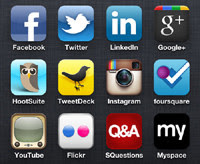 |
| The twitpic heard 'round the world. Image: Oreo. |
Now that you've had a little time to absorb an 108-yard touchdown and a 34-minute power outage, let's take another look at all of those insane 2013 Super Bowl ads. I want to talk to you about what we, as stewards of (slightly) smaller brands can learn. We probably won't have 3.8 million to spend on a 30-minute spot anytime soon, but there are some good lessons nonetheless.
1) Tell a great story, but connect it to something related. Commercials from Jeep (agency: GlobalHue) and Dodge (agency: The Richards Group) told great stories, with high quality imagery and emotionally gripping content. Unfortunately, at the end of a heart-wrenching story about how much we want those in our military to come home safe, we're pitched a sport utility vehicle, rather than, say, a donation to the Wounded Warrior Project. The Dodge commercial had the same issue. We're called upon to stop taking farmers for granted and to realize the true value of American agriculture, and just when we're moved to support our local 4H or CSA, we're sold a pickup truck.
2) If you truly have the connection, then capitalize on that. Don't be theoretical about it. These ads got high ratings (though they aren't generating a lot of vehicle purchase consideration), but the retired service members who were at the Super Bowl party I went to felt manipulated and felt the tie-ins to Dodge and Jeep were inappropriate. The worst part is that Dodge and Jeep are big supporters of Future Farmers of America and the USO, respectively. But they were unable to make the most of these connections in their ads because they didn't effectively explain (at least not to the folks at my party) what was going on with these partnerships. There was a Jeep/USO logo at the end of the Jeep ad, but my fellow partygoers were so turned off by the ad that they weren't paying attention. The Dodge ad never seems to mention FFA. How do you think these ads would have been received if they'd opened with each brand explaining how and why it supported its partner non-profit? Don't assume that your audience knows everything about your brand.
3) Make the most of the moment. Marketers like us have heard a lot this week about Oreo's timely tweet in the midst of the Super Bowl power outage. How did they do it? They put together a war room of everyone involved in their campaign (designers, writers, creative directors, Oreo's own brand messengers, etc.) so that they could get content created, approved, and published in record time. At smaller organizations, we aren't going to have such complex structures, but we can take a lesson from this: Think about opportunities you might have this year to capitalize on events in real time, and figure out who would need to be in the room if you wanted to turn on a dime like Oreo.
What did you think about this year's Super Bowl ads? More backward sexism and cultural stereotyping than last year, or less? Better music and dancing? Cuter baby animals? Let me know which ones you liked and which ones made you wanna go "meh."



